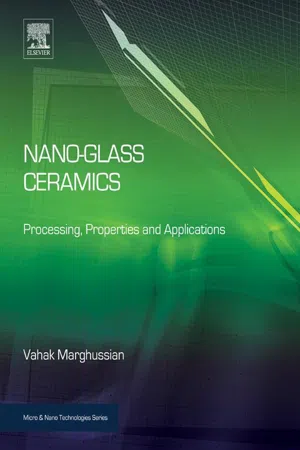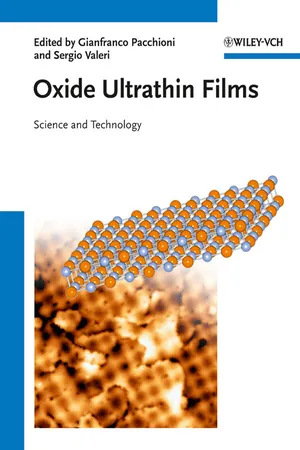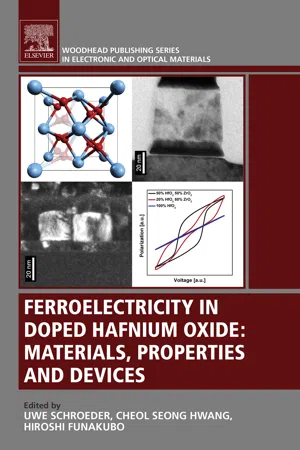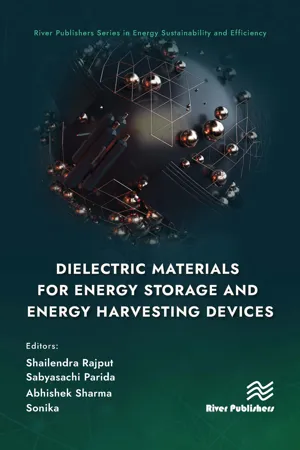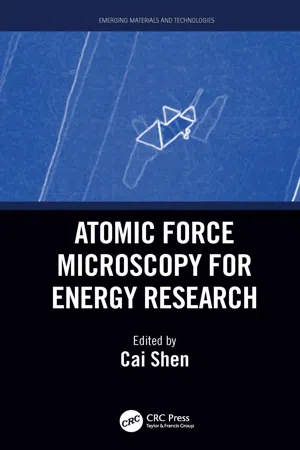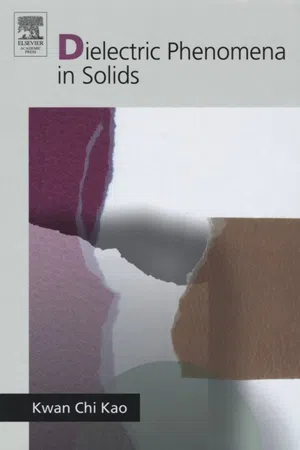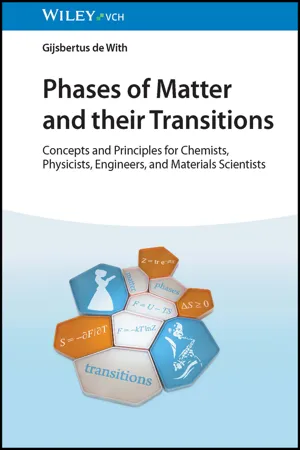Technology & Engineering
Ferroelectricity
Ferroelectricity is a property exhibited by certain materials where they can retain a spontaneous electric polarization even in the absence of an external electric field. This polarization can be reversed by applying an external electric field, making ferroelectric materials useful for applications in memory devices, sensors, actuators, and capacitors. The unique properties of ferroelectric materials make them valuable in various technological advancements.
Written by Perlego with AI-assistance
Related key terms
Related key terms
1 of 4
Related key terms
1 of 3
12 Key excerpts on "Ferroelectricity"
- eBook - ePub
- Haitao Huang, James F. Scott, Haitao Huang, James F. Scott(Authors)
- 2018(Publication Date)
- Wiley-VCH(Publisher)
1 Fundamentals of Ferroelectric MaterialsLing B. Kong1, 2 , Haitao Huang3 , and Sean Li41 Shenzhen Technology University, College of New Materials and New Energies, 3002 Lantian Road, Shenzhen, Guangdong, 518118, PR China2 Nanyang Technological University, School of Materials Science and Engineering, 50 Nanyang Avenue, Singapore, 639798, Singapore3 Hong Kong Polytechnic University, Department of Applied Physics, 11 Yuk Choi Road, Hung Hom, Kowloon, Hong Kong4 The University of New South Wales, School of Materials Science and Engineering, High Street, Kensington, Sydney, NSW, 2052, Australia1.1 Introduction
Ferroelectricity is defined as the property of a material, with two characteristics, i.e. (i) spontaneous polarization is present and (ii) it is reversible when subjected to external electric fields [1] . The property was first observed in Rochelle salt and is named so because of its analogy to ferromagnetism, which is a magnetic property of a material that has a permanent magnetic moment [2 , 3 ]. Other similarities include hysteresis loop, Curie temperature (T C), domains, and so on. The prefix, ferro, meaning iron (Fe), was used at that time because of the presence of the element in the magnetic materials. However, Ferroelectricity has nothing to do with Fe. Even though some ferroelectric materials contain Fe, it is not the originating factor.Generally, as a material is polarized by an external electric field, the induced polarization (P) is linearly proportional to the magnitude of the applied external electric field (E), which is known as dielectric polarization. Above the Curie temperatureT C, ferroelectric materials are at a paraelectric state. In this case, a nonlinear polarization is present versus an external electric field. As a result, electric permittivity, according to the slope of the polarization curve, is not a constant. At the ferroelectric state, besides the nonlinearity, a spontaneous nonzero polarization was present, as the applied field (E - eBook - ePub
Hybrid Perovskite Solar Cells
Characteristics and Operation
- Hiroyuki Fujiwara(Author)
- 2021(Publication Date)
- Wiley-VCH(Publisher)
12 ] microscopic electric fields in insulating ferroelectric domain assemblies produce higher‐than‐usual photovoltages (similar to tandem solar cells), but their negligible device currents, to date, render the concept rather inefficient. In contrast, this chapter deliberately focuses on semiconducting thin films, which operate as single light‐harvesting layers in solar cells.7.2 Ferroelectricity
The (macroscopic) textbook definition of Ferroelectricity is the existence of a spontaneous polarization that is switchable between at least two polarization states under an external electric field [13 ]. Microscopically, ferroelectric materials form domains with spontaneous polarization. These properties of ferroelectric materials find their origin in the crystal structure.7.2.1 Crystallographic Considerations
The crystal structure and its symmetry determine most of the fundamental properties of a crystalline material such as its conductivity, its band structure, and its ferroic properties, the latter of which includes ferromagneticity, ferroelasticity, and Ferroelectricity. Symmetry elements, including rotational symmetries, mirror symmetries, and inversion, define 32 fundamental crystal classes. In general, Ferroelectricity requires a unit cell that exhibits a polar axis, which can only occur in non‐centrosymmetric crystals. Non‐centrosymmetry is synonymous with a lack of inversion symmetry in the unit cell of the crystal. Figure 7.1 a illustrates non‐centrosymmetry in a hypothetic two‐dimensional crystal comprising two different atomic constituents. The polar axes prevent the congruent lattice inversion at the center of the unit cell [14 ].Illustration of the piezoelectric effect in a hypothetic two‐dimensional, non‐centrosymmetric crystal comprising two types of atoms. (a) The configuration of atoms forms three polar axes, which preclude inversion symmetry. (b) Upon application of a mechanical force along one of the polar axes, the displacement of atoms creates a polarization.Figure 7.1Out of the 32 crystal classes, 20 exhibit one or more polar axes in the unit cell, making the crystal piezoelectric. By applying an external mechanical force along one of the polar axes as illustrated in Figure 7.1 b, atoms are displaced, inducing an electric polarization and hence a charging of the crystal faces perpendicular to the polar axis. Similarly, an externally applied electrical field deforms the crystal along one of the polar axes (inverse or converse piezoelectric effect). In 10 out of the 20 piezoelectric crystal classes, a unique polar axis exists and intrinsic dipole moments in the unit cell form a spontaneous polarization even in the absence of an external electric field [15 ]. In these crystal classes the polarization magnitude changes upon application of a temperature gradient, and hence the crystal is considered pyroelectric. Changes in the permanent dipole moments become detectable in variations of the surface potential until surface charges have screened and compensated the pyroelectric polarization. Among the pyroelectric materials, some crystals exhibit a permanent spontaneous polarization with at least two different equilibrium states. The crystal can switch between those states if a sufficiently large external electric field is applied. The occurrence of different equilibrium states of spontaneous polarization characterizes Ferroelectricity. Thus, every ferroelectric material is also pyroelectric and piezoelectric, but not necessarily vice versa. The spontaneous polarization in ferroelectrics can originate either from ordered intrinsic electric dipole moments or from displaced atoms in the unit cells, thus creating a polar axis [14 ]. For example, in a tetragonal crystal (axes cT > aT = bT ; angles between axes: 90°), displaced atoms along the cT ‐axis can induce Ferroelectricity. Above the Curie temperature - eBook - ePub
Nano-Glass Ceramics
Processing, Properties and Applications
- Vahak Marghussian(Author)
- 2015(Publication Date)
- William Andrew(Publisher)
Some dielectric materials exhibit a spontaneous polarization in the absence of an applied field which can be reversed by an externally applied electric field. This behavior is called the ferroelectric effect.Ferroelectric behavior is limited to certain materials and to particular temperature ranges for a given material. Above a certain temperature, known as Curie point, T c , the spontaneous polarization falls to zero and the properties change to those of a paraelectric (Moulson and Herbert, 2003 , pp. 59–60).Many ferroelectrics possess very high-permittivity values making them quite useful for capacitors. The permittivity that varies considerably with both applied field strength and temperature usually reaches a peak at the Curie point and falls off at higher temperatures (Moulson and Herbert, 2003 , pp. 59–60).The reason for coining the term “ferroelectric” is that the relationship between field and polarization for a ferroelectric material bearing electrodes takes the form of a hysteresis loop similar to that relating magnetization and magnetic field for a ferromagnetic body.Various models have been suggested to explain why some materials are ferroelectric. The most recent and successful model involves a consideration of the vibrational states of the crystal lattice (Moulson and Herbert, 2003 , pp. 59–60).Some dielectrics can generate a potential difference when subjected to mechanical stress or change physical shape if an external voltage is applied across the material. This property is called piezoelectricity . Piezoelectric materials are another class of very useful dielectrics.Polar dielectric materials also exhibit pyroelectric effect. True pyroelectricity results from the temperature dependence of the spontaneous polarization P s - eBook - ePub
Oxide Ultrathin Films
Science and Technology
- Gianfranco Pacchioni, Sergio Valeri(Authors)
- 2012(Publication Date)
- Wiley-VCH(Publisher)
This is a particularly exciting time for nanoscale physics, as the experimental advances in materials preparation and characterization have come together with great progress in theoretical modeling of ferroelectrics, and both theorists and experimentalists can finally probe the same length and time scales. This allows real-time feedback between theory and experiment, with new discoveries now routinely made both in the laboratory and on the computer. Throughout this chapter, we will highlight the recent advances in density functional theory (DFT)-based modeling and the role it plays in our understanding of ultrathin ferroelectrics. We will begin with a brief introduction to Ferroelectricity and ferroelectric oxides in Section 12.2, followed by an overview of the major theoretical developments in Section 12.3. We will then discuss some of the subtleties of Ferroelectricity in perovskite oxides in Section 12.4, before turning our attention to the main subject of the chapter – Ferroelectricity in ultrathin films – in Section 12.5. In this section we will discuss in detail the influence of the mechanical, electrical, and chemical boundary conditions on the stability of the polar state in a parallel-plate capacitor geometry, introducing the notion of depolarization fields that tend to destabilize Ferroelectricity. In Section 12.6, we will look at other ways in which a thin ferroelectric can preserve its polar state, focusing on ferroelectric domains and domain walls. Finally, in Section 12.7 we will briefly discuss artificially layered ferroelectrics and the potential they hold as tailor-made materials for electronic applications.Of course, it is impossible to summarize 90 years of research within the scope of this chapter. We will only review some of the stimulating developments that have taken place in the field of ferroelectric thin films within the last few years and will point the attention of the interested reader to the most comprehensive books and reviews summarizing the state of the art of this exciting field of research, both theoretically and experimentally.12.2 Ferroelectricity: Basic DefinitionsFerroelectrics are materials exhibiting a spontaneous electric polarization that can be switched by applying an electric field. The value of the spontaneous polarization can vary over several orders of magnitude depending on the material (see Figure 12.1a ). The word “ferroelectric” is actually somewhat of a misnomer as these materials rarely contain iron. The prefix “ferro” was instead adopted by analogy with the more mature field of ferromagnetism, which has many parallels with Ferroelectricity: (i) a ferromagnet has a spontaneous magnetization that can be switched by an external magnetic field; (ii) the switching process can be associated in both cases with a hysteresis loop (see Figure 12.1b ); (iii) very often there is a coupling between polarization (either magnetic or electric) and the shape of the unit cell (strain); (iv) both ferroelectric and ferromagnetic polarization decrease with increasing temperature up to a critical T c , where a phase transition to a high-symmetry unpolarized phase takes place and the corresponding polarization order parameter vanishes; and (v) even below T c the macroscopic polarization might vanish if the homogeneously polarized state breaks into domains - eBook - ePub
Ferroelectricity in Doped Hafnium Oxide
Materials, Properties and Devices
- Uwe Schroeder, Cheol Seong Hwang, Hiroshi Funakubo(Authors)
- 2019(Publication Date)
- Woodhead Publishing(Publisher)
Chapter 1Fundamentals of Ferroelectric and Piezoelectric Properties
Jon F. Ihlefeld* , †* Department of Materials Science and Engineering, University of Virginia, Charlottesville, VA, United States† Department of Electrical and Computer Engineering, University of Virginia, Charlottesville, VA, United StatesAbstract
Piezoelectric and ferroelectric materials find usage in myriad applications, ranging from resonators for timekeeping instruments to ultrasound transducers to low-power nonvolatile memory elements, among many others. As a result of the vast application space, there is a drive to discover new materials with improved performance, lower cost, easier manufacturing possibilities, and reduced environmental impact. This chapter serves to outline the basic properties of piezoelectric and ferroelectric responses and discusses properties that must exist in piezoelectric and ferroelectric materials, focusing first on the necessary crystal symmetries to support the phenomena. The discussion then expands to the phenomenological thermodynamic theory of the phase transition from the nonpolar to the polar phase and a description of how phonons and atomic displacements form spontaneous dipoles. Finally, several key features and phenomena of ferroelectrics are discussed, including domain structure, scaling effects, ferroelectric fatigue, and property measurements and artifacts.Keywords
Ferroelectricity; Piezoelectricity; Symmetry; Domains; Measurements1.1 Piezoelectricity and Ferroelectricity
Piezoelectricity is a linear response of charge development on a crystal surface with an applied stress. The converse piezoelectric effect is a linear strain response to an applied electric field. The important consideration for both effects is that the response is linear, which distinguishes it from quadratic proportionalities of strain versus field that are present in all materials and are known as electrostrictive effects. Piezoelectric coefficients quantify the proportionality between applied stress and charge and strain and electric field, as described in Eqs. (1.1) and (1.2) - Shailendra Rajput, Sabyasachi Parida, Abhishek Sharma, Sonika(Authors)
- 2023(Publication Date)
- River Publishers(Publisher)
In the case of polar dielectric, the polarization appears due to the unit cell’s inherent symmetry, giving rise to electronic/ionic polarization and creating a dipole moment. Thus, ferroelectric materials have spontaneous polarization which could be reversed by applying a reverse electric field. The polarization reversal of dielectric was first observed by Valasek in 1920 [ 1 ]. The non-linear relation of polarization with the electric field is one of the main features of ferroelectrics [ 2, 3, 4 and 5 ]. Nye [ 6 ] and Bhagavantam [ 7 ] discussed the effect of symmetry on the properties of the crystal. There are in total 32 possible point groups based on crystal symmetry elements. For a material to show ferroelectric properties it should lack a centre of symmetry (necessary but not strictly a required condition). There are 21 classes and 32-point groups that lack a centre of symmetry of which 20 crystal classes could be polarized under external stress and such type of material is called piezoelectric materials. A total of 10 out of such piezoelectric groups also show pyroelectric behaviour. As the temperature changes, polarization is observed in the form of a pyroelectric current. Ferroelectrics are a subgroup of pyroelectric in which polarization could be reoriented or reversed by applying a reverse external field. A typical ferroelectric has spontaneous polarization which decreases with temperature and disappears at a particular temperature, which is known as Curie temperature (T C) [ 8 ]. At this temperature, the material undergoes a transition from ferroelectrics to paraelectric phase. The paraelectric phase is more symmetric than the corresponding ferroelectric phase- Emil Zolotoyabko(Author)
- 2021(Publication Date)
- Wiley-VCH(Publisher)
12 Ferroelectricity as a Cooperative PhenomenonFerroelectric crystals. Ferroelectric phase transitions: The Landau–Ginzburg theory. Dielectric permittivity near Curie temperature. Ferroelectric domains and domain walls. The piezoelectric effect in ferroelectrics. Ferroelectrics-based devices.Ferroelectricity, i.e. the presence of spontaneous dielectric polarization (macroscopic dipole moment in the sample) in a zero electric field, in many aspects is similar to ferromagnetism. For example, ferroelectric materials reveal polarization reversal upon application of an electric field and formation of domain structures. The origins of these two phenomena, however, are very different. Ferromagnetism, as we know, originates in magnetic moments (axial vectors) of not-fully filled electron shells in atoms. In contrast, Ferroelectricity originates in electric dipole moments, arising as a result of the displacement type or order–disorder type phase transitions in crystal lattices, which are accompanied by a change in the crystal symmetry that allows a polar vector in a crystal to exist.Ferroelectricity was discovered in 1920 by Joseph Valasek during his experiments with Rochelle salt crystals. This salt, potassium sodium tartrate tetrahydrate, has the chemical formula KNaC4 H4 O6 ·4H2 O and in its paraelectric high-temperature phase belongs to the orthorhombic symmetry system (centrosymmetric point group 222). Phase transition to the ferroelectric phase occurs at 24 °C and is accompanied by symmetry reduction down to the monoclinic non-centrosymmetric point group 2. The ferroelectric phase is maintained until −18 °C; at this temperature the crystal symmetry returns to point group 222 and Ferroelectricity is lost. The maximum spontaneous polarization, 0.25 μC/cm2- eBook - ePub
- Pradeep Fulay, Jung-Kun Lee(Authors)
- 2016(Publication Date)
- CRC Press(Publisher)
10 Ferroelectrics, Piezoelectrics, and PyroelectricsKEY TOPICS- Ferroelectric materials
- Origin of Ferroelectricity
- Ferroelectric hysteresis loop
- Properties and applications of ferroelectrics
- Electrostriction
- Piezoelectric materials
- Direct and converse piezoelectric effects and applications
- Properties and applications of soft and hard piezoelectrics
- Strain-tuned ferroelectrics
- Lead-free piezoelectrics
- Pyroelectric materials and applications
10.1 FERROELECTRIC MATERIALS
10.1.1 FERROELECTRICITY IN BARIUM TITANATEFerroelectrics are materials that possess a macroscopic spontaneous polarization that can be reoriented through the application of an external electric field (Schlom et al. 2007). Polarization in ferroelectric materials can exist in the absence of an electric field under certain ranges of temperature and pressure. This is the biggest difference between ferroelectric materials and dielectric materials. In dielectric materials, polarization is also generated by applying an electric field. However, the polarization of dielectric materials disappears when the electric field is not applied. Ferroelectric materials have crystal structures that lack inversion symmetry. This broken inversion symmetry is a source of permanent polarization that is observed in ferroelectrics.We can summarize the origin of Ferroelectricity in tetragonal barium titanate (BaTiO3 ), an archetypal ferroelectric, as follows.The temperature at which the transformation occurs from a nonpolar, paraelectric phase to a polar, ferroelectric phase is known as the Curie temperature (T c ). At a given temperature higher than the Curie temperature, materials may exhibit a cubic structure. For BaTiO3 , this temperature is ∼120°C. In this cubic phase, also called the paraelectric phase, the titanium (Ti4+ ) ion appears to be exactly at the center of the cube. In reality, of course, ions are not stationary. The titanium ion, for example, vibrates very rapidly around several equivalent off-center positions. Each of these off-center configurations has a net dipole moment, which rotates very rapidly in space. The result is that the time-averaged position of the titanium ion in the cubic, paraelectric phase appears to be at the center, and this higher-temperature polymorph of BaTiO3 - eBook - ePub
Negative Capacitance Field Effect Transistors
Physics, Design, Modeling and Applications
- Young Suh Song, Shubham Tayal, Shiromani Balmukund Rahi, Abhishek Kumar Upadhyay, Young Suh Song, Shubham Tayal, Shiromani Balmukund Rahi, Abhishek Kumar Upadhyay(Authors)
- 2023(Publication Date)
- CRC Press(Publisher)
ᵣ may be negative, i.e., permittivity will be negative, which reflects negative capacitance (NC). In general, such a phenomenon could be possible with ferroelectric, ferrielectric, and antiferroelectric materials.5.3 Origins of Negative Capacitance in Ferroelectrics
Ferroelectric materials are among the most used materials in devices that reflect permanent spontaneous polarization even in the absence of an external electric field owing to their non-centrosymmetric crystal structure that can be reversed under the influence of a stronger external electric field as compared to their coercive field [38 ]. Such characteristics in materials are more useful in memory storage devices due to their flipping polarization as a function of the electric field [39 ]. This tuning in the polarization of such crystal-structured materials is also done through variations in temperature and the application of stress to utilize their features in ultrasonic transducers and infrared detectors [40 ].The spontaneous permanent polarization of the material depends on its existing molecular structure. Therefore, permanent polarization in any material is the result of its constituent features and the material which has been made up of a set of molecules which contains one or more stable molecules. These molecules change their constituent atom positions with time due to any external forces applied on them. For example, a unit cell (as a representative) of ferroelectric material is shown in Figure 5.4 (a), where the central atom (blue) is situated in the upper half (i) of the unit cell and as the applied potential/voltage increases on the ferroelectric material, the central blue atom starts moving to the lower half portion (ii) of the unit cell and comes to a stable position in the lower half part of the unit cell as shown in Figure 5.5 (b). As the applied potential/voltage starts to decrease across the ferroelectric it starts to move to its original/initial position, i.e., it shifts to the upper half of the unit cell as shown in Figure 5.5 (a). This complete position transition phenomenon in the unit cell defines the material polarization direction or flipping polarization with an external electric field. This complete phenomenon of polarization as a function of an external electric field can be represented as a hysteresis loop, as shown in Figure 5.5 (c), in which the blue atom position in the upper half is represented in the first quadrant while the reverse position i.e., the blue atom lower half position, is represented in the third quadrant. The second and fourth quadrant positions are very sharply changed as compared to the first and third quadrants with an electric field, i.e., it is the position of instability of the blue atom in the unit cell. This position of instability is also reflected in the stored energy versus polarization plot [Figure 5.4 (d)]. This unstable blue atom position between positions (i) and (ii) is represented in Figure 5.5 within the energy range, i.e., between the stable position, an unstable position of the atom exists, as shown by the half inverted parabola shape. The unstable position energy range starts from zero to nearly half of the stable position energy with respect to positive and negative polarization within the external critical electric field, as shown between the dashed line that represents the negative capacitance region [Figures 5.5(a,b)]. The Ef –1 versus Ps plot represents the unstable regions, i.e., (iii) in Figure 5.5 - eBook - ePub
- Cai Shen, Cai Shen(Authors)
- 2022(Publication Date)
- CRC Press(Publisher)
1The mainstream of ferroelectric materials are inorganic oxides, in contrast, only very limited organic materials show Ferroelectricity. Among these, the fluoropolymer PVDF and the copolymer of VDF-TrFE may be seen as the prototype and the most widely used organic ferroelectric/piezoelectric materials. Compared to the inorganic materials, the properties of ferroelectric polymers like ease fabrication, mechanical flexibility and large area processing are highly desirable for the many emerging portable and wearable sensors and other devices. As a consequence, the fluoropolymer has become the focus of an overwhelming amount of work, particularly as energy conversion materials for new flexible devices and self-powered systems.2 ,3 ,4 and 5The Ferroelectricity and piezoelectricity of the fluoropolymer originates from the regularly aligned H-C-F dipoles in the molecular chain. Polymorph is a common for polymer. The ferroelectric fluoropolymer mainly shows four phases, while only the polar phases show piezoelectricity, particularly the β-phase with all-trans conformation. However, the phase change and microstructural characteristics of the copolymer are very complicated and still far from being fully understood. Analyzing the complicated phase change and microstructural characteristics of the fluoropolymer is a key issue of paramount importance for their application. Therefore, one of the main topics for the ferroelectric polymer research is the phase change. Appropriate microscope is an indispensable tool for microstructure analysis and for material performance modification. For polymer, the widely used high-resolution facility like electron microscopes have serious disadvantages. The radiation damage by electron beam is an inevitable and serious factor that limits the amount of microstructural information that can be collected. In comparison, atomic force microscopy (AFM)-based facilities are much more desirable because of the damage-free nanometer resolution imaging ability.6 ,7 and 8 - eBook - ePub
- Kwan Chi Kao(Author)
- 2004(Publication Date)
- Academic Press(Publisher)
Chapter 3 . In this section, we shall briefly describe some applications related directly to the special features of ferroelectrics: mainly, spontaneous polarization, nonlinearity, and hysteresis behavior.Figure 4-30 The effects of a mechanical stress, an electric field, or a temperature change on the behavior of a poled ferroelectric specimen.Capacitors
Capacitors are important elements in electrical and electronic circuits, performing various functions that include blocking, coupling and decoupling, AC-DC separation, filtering, power factor correction, energy storage, etc. For a capacitor with the dielectric material of dielectric constant εr and thickness d between two parallel metallic plates of area A , the capacitance is given by(4-51)If the working voltage is V , the average working field F is V/d , which must be lower than the breakdown strength of the dielectric materialFbby factor k . The volume efficiency of the capacitor is defined as(4-52)The maximum permissible energy density stored in the capacitor is thus(4-53)The value of , is a figure of merit for dielectrics.All dielectric materials have a finite value for DC resistivity. Thus, a charged capacitor will discharge gradually through its own resistance following(4-54)whereQoand Q(t) are, respectively, the initial charge and the charge remaining in the capacitor at time t ; τ is the dielectric relaxation time of the material, which is equal to εr ε0 ρ; and ρ is the resistivity of the material. A capacitor dissipates its stored energy through DC leakage resistance and, more importantly, the dielectric losses under an AC electric field. These account for the dissipation factor or the loss tangent tanδ (see Section 2.2.3 in Chapter 2 ). It should also be noted that the leads and the electrodes always introduce an inductance L in the circuit. This is why a capacitor has a resonance frequency which may be very high, depending on the value of L . For general applications, it is important to keep the value of the unwanted stray inductance L - eBook - ePub
Phases of Matter and their Transitions
Concepts and Principles for Chemists, Physicists, Engineers, and Materials Scientists
- Gijsbertus de With(Author)
- 2023(Publication Date)
- Wiley-VCH(Publisher)
[52] ).Table 17.5 summarizes some properties of the ferroelectrics indicated. The transformation temperature T0 for polycrystalline ferroelectrics is essentially the same as for single crystals but changes with pressure. For BaTiO3 , for example, T0 increases with 2.6 × 10−3 K bar−1 and decreases with 5.7 × 10−3 K bar−1 for TGS. The maximum polarization Pmax that can be reached is, however, lower than that of single crystals. For example, for BaTiO3 the maximum is 84% [55] , but in practice due to the presence of pores and stresses typically 50% or less. Still, Pmax obtained is large and the spontaneous polarization Psp = 0.26 μC m−2 of single‐crystalline BaTiO3 , for example, implies a charge +e and −e separated by ≅1 Å for every cell.Characteristics of some typical ferroelectrics.Table 17.5Source: Burfoot [54] /with permission of Cengage Learning.Material T0 (°C)C (K)a)Order Psp (μC cm−2 )b)Δtra H (cal mol−1 )BaTiO3 120 1.3 × 104 1 20 (T0 ), 26 (RT) 47 PbTiO3 490 8.9 × 103 1 57–75 [53] 1150 KH2 PO4 (KDP) −150 259 1 → 2 4.8 (T0 –27) 87 (NH2 CH2 COOH)3 H2 SO4 (TGS) 49 255 2 2.8 (RT) 150 a) ε1 = C/(T − T0 ).b) Spontaneous polarization at the temperature indicated.In summary, ferroelectrics are a subgroup of pyroelectrics, just as pyroelectrics are a subgroup of piezoelectrics, while the latter are a subgroup of dielectrics. While originally ferroelectric behavior was considered as exceptional, nowadays many ferroelectric compounds are known. Jona and Shirane [49] provide many experimental details on single crystals. Other references are the books by Fatuzzo and Merz [56] and Burfoot [54] . The classic is the book by Lines and Glass [43] to which Rabe et al. [57] is complementary. Grindlay [58] provided a detailed exposition of the macroscopic approach, as did Salje [59] . Domain structure is discussed in [60 , 61
Index pages curate the most relevant extracts from our library of academic textbooks. They’ve been created using an in-house natural language model (NLM), each adding context and meaning to key research topics.
Explore more topic indexes
Explore more topic indexes
1 of 6
Explore more topic indexes
1 of 4


